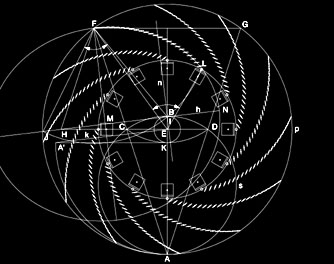
|
p
a v i l i o n # 1 / g e o m e t r y
|

|
p
a v i l i o n # 1 / g e o m e t r y
|
| by Reinhard Haslwanter and Hofstetter Kurt, 1999 |
 |
| The
geometry of the spiral as spatial translation and rotation - respectively
parallelism and circulation - formulates a specific transition between
inner and outer space. The construction principle of this spiral is based
on the Golden Section, which by itself results from the light of the sun
and the rotation of the earth. Through iterative use of this principle,
beginning with a single unit of 1 cm, it is possible to derive all dimensions
using only a set of compasses and a ruler. After 14 iterations the resulting
dimension is 843 cm, which is the diameter of the circle of the 12 supporting
pillars.
Let s be a circle with the diameter AB = 843 cm. A Golden Triangle ACD is inscribed in this circle. The height AE of this Golden Triangle is the outer radius of the pavilion. E is the resulting mid-point of the pavilion and thus the centre of the pillar-ring. Into the outer circle another Golden Triangle AFG is constructed. The corner F marks the starting point of an arc of lamellas, generated by an ellipse. The geometry of the ellipse as planar translation and rotation - respectively parallelism and circulation - can again be constructed according to the Golden Section: the
vertex of the minor half-axis is F;
* the
chord length of the arc of lamellas is FI ( = distance F to pillar L)
In the closed position the lamellas are oriented parallel to the major axis of the ellipse. Each arc of lamellas is tangential to the chord of the following one – no light beam can directly reach the space inside the ring of pillars. In the opened position the lamellas are parallel to the minor axis. Thus a maximum of transparency is achieved – the light of the screens streams outside in an ideal way. |